随着水体氮素污染问题的日趋严重, 生物脱氮已经成为废水处理研究领域的热点[1].传统的生物脱氮过程包括硝化和反硝化[2], 其存在过程相对复杂、耗能高、碳源需求量大等缺点, 不适用于低氮碳比(C/N)废水的脱氮处理[3].
同步短程硝化-厌氧氨氧化-反硝化(SNAD)过程是一种新型生物脱氮工艺[4~6].短程硝化可为厌氧氨氧化过程创造条件, 厌氧氨氧化过程可将NH4+和NO2-转化为N2, 反硝化过程可利用有机物进一步去除NO2-和NO3-[7, 8].在适宜条件下, SNAD过程可实现COD和总氮(TN)的同步去除[9], 为高氨氮浓度、低C/N比废水的生物脱氮提供了高效低耗的新途径[10].
微气泡曝气生物膜反应器是微气泡曝气技术在废水生物处理中的可行应用, 能够实现连续稳定运行和高效处理性能以及接近100%的氧利用率[11~14].同时, 微气泡曝气生物膜反应器亦可以实现同步硝化-反硝化生物脱氮[15].同样, 生物膜内氧浓度梯度可以为亚硝化细菌、厌氧氨氧化细菌和反硝化细菌的生长提供适宜的生长环境, 具有实现SNAD过程的可行性, 从而有效处理低C/N比废水.
本研究利用微气泡曝气生物膜反应器极高的氧利用率, 在低气水比和低C/N比条件下, 实现SNAD生物脱氮过程, 并获得较高的生物脱氮效率.同时, 通过高通量测序分析反应器内生物膜脱氮功能菌群变化, 探究SNAD生物脱氮过程的微生物学机制, 为SNAD生物脱氮过程的应用提供理论和技术支持.
1 材料与方法 1.1 实验装置本研究采用的微气泡曝气生物膜反应器如图 1所示.微气泡发生装置为OHR混合管式微气泡发生器(北京晟峰恒泰科技有限公司), 实验条件下产生空气微气泡平均直径范围为30~40 μm.生物膜反应器为有机玻璃柱体, 直径为240 mm, 有效容积为60 L.反应器内悬挂5根直径40 mm、长1200 mm的辫带式生物填料(河北益生环保科技有限公司), 作为生物膜生长载体.微气泡曝气生物膜反应器采用底部连续进水、顶部溢流出水的方式运行.

|
图 1 微气泡曝气生物膜反应器实验装置示意 Fig. 1 Schematic diagram of microbubble aerated biofilm reactor |
微气泡曝气生物膜反应器的连续运行过程可分为启动(挂膜)阶段和稳定运行阶段(Phase 1~Phase 3).运行过程中, 逐步降低有机负荷并提高TN负荷以降低C/N比, 同时控制运行气水比小于1:2, 通过降低空气流量使得反应器内溶解氧(DO)浓度逐渐低于1.0 mg·L-1.各阶段运行条件见表 1.
|
|
表 1 运行条件 Table 1 Running conditions |
启动(挂膜)阶段前, 向反应器内接种某城镇污水处理厂二沉池回流污泥, 初始接种污泥浓度(MLSS)约为0.8 g·L-1, 闷曝48 h后将悬浮污泥排出, 然后投加人工模拟生活污水, 以葡萄糖为碳源, 以NH4Cl为氮源, 调节葡萄糖和NH4Cl投加量以控制C/N, 同时添加P、Ca、Mg、Fe、Mn等微量元素, 以及添加NaHCO3调节pH并提供无机碳源[16, 17].按照设定条件连续运行.运行温度为30℃±2℃, 进出水pH范围为7.4~8.2.
运行过程中, 测定进出水COD、氨氮、TN、亚硝酸盐氮、硝酸盐氮浓度及DO浓度和生物膜生物量变化, 并在各阶段结束时检测分析生物膜细菌群落结构和脱氮功能菌群变化.
1.3 分析方法水质指标COD、氨氮、硝酸盐氮、亚硝酸盐氮、TN等, 均采用国标方法测定. DO浓度采用溶解氧测定仪(Cell Oxi330, 德国WTW)测定.
反应器运行过程中, 每7 d取生物膜样品, 测定并核算反应器内生物膜生物量(以SS和VSS浓度计)[18, 19].同时在各个运行阶段结束时, 收集生物膜样品, 进行高通量测序(上海派森诺生物科技股份有限公司), 分析生物膜样品细菌种群结构和功能菌群丰度变化[20].
2 结果与讨论 2.1 污染物去除性能 2.1.1 COD去除性能微气泡曝气生物膜反应器各阶段COD进出水浓度及去除率变化如图 2所示.可以看到, 启动阶段完成后, 稳定运行的Phase 1~Phase 3阶段进水COD平均浓度分别为109.1、57.9和55.2 mg·L-1, 出水COD平均浓度分别为19.1、13.3和12.7 mg·L-1, COD平均去除率分别为82.5%、77.1%和77.0%, COD平均去除负荷分别为1.08、0.54和0.51 kg·(m3·d)-1.
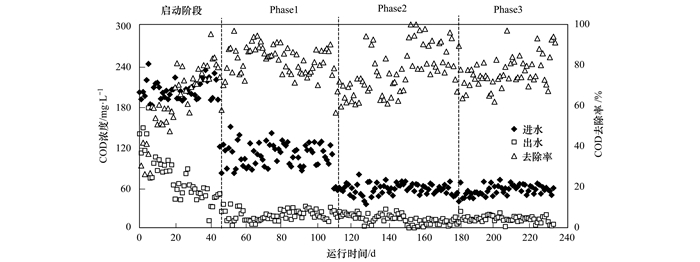
|
图 2 微气泡曝气生物膜反应器COD去除性能 Fig. 2 COD removal performance in the microbubble aerated biofilm reactor |
可见, 启动阶段完成后, Phase 1~Phase 3阶段COD去除率基本保持稳定, 且随着进水COD负荷降低, COD去除负荷随之下降.微气泡曝气生物膜反应器可以获得稳定的COD去除性能.
2.1.2 氨氮去除性能微气泡曝气生物膜反应器各阶段氨氮进出水浓度及去除率变化如图 3所示.可以看到, 启动阶段完成后, 稳定运行的Phase1~Phase3阶段进水氨氮平均浓度分别为108.1、96.8和154.7 mg·L-1, 出水氨氮平均浓度分别为31.9、27.9和35.2 mg·L-1, 平均氨氮去除率分别为70.5%、71.2%和77.2%, 氨氮平均去除负荷分别为0.91、0.83和1.43 kg·(m3·d)-1.
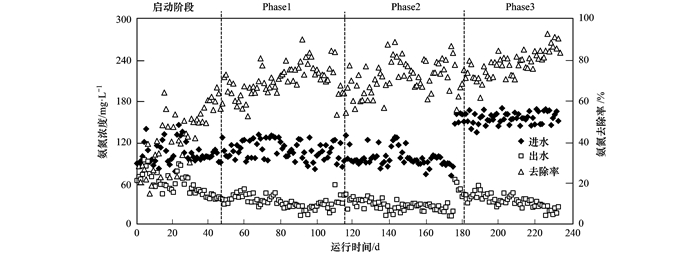
|
图 3 微气泡曝气生物膜反应器氨氮去除性能 Fig. 3 Ammonia nitrogen removal performance in the microbubble aerated biofilm reactor |
可见, 启动阶段氨氮去除率逐渐升高.启动阶段完成后, Phase1~Phase2阶段氨氮去除率和去除负荷基本保持稳定. Phase3阶段尽管进水氨氮负荷升高, 但氨氮去除率又有所提高, 氨氮去除负荷亦随之升高, 其氨氮去除性能明显优于其它阶段.
2.1.3 TN去除性能微气泡曝气生物膜反应器各阶段TN进出水浓度及去除率变化如图 4所示.可以看到, 启动阶段完成后, 稳定运行的Phase1~Phase3阶段出水TN平均浓度分别为32.8、28.7和36.6mg·L-1, TN平均去除率分别为69.7%、70.4%和76.3%, 总氮平均去除负荷分别为0.90、0.82和1.42 kg·(m3·d)-1.
TN去除过程与氨氮去除过程类似, 启动阶段TN去除率逐渐升高.启动阶段完成后, Phase1~Phase2阶段TN去除率基本保持稳定. Phase3阶段尽管进水TN负荷升高, TN去除率同样有所升高, TN去除负荷亦随之升高, 其TN去除性能明显优于其它阶段.
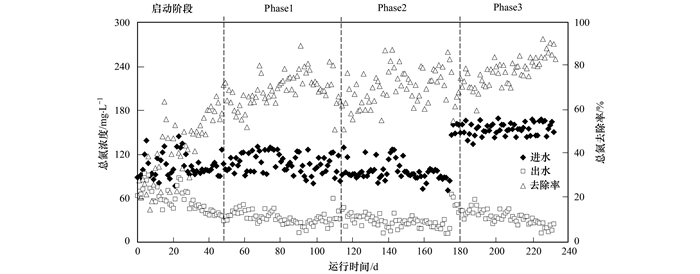
|
图 4 微气泡曝气生物膜反应器总氮(TN)去除性能 Fig. 4 Total nitrogen (TN) removal performance in the microbubble aerated biofilm reactor |
运行各阶段进水中氮的存在形式仅有氨氮, TN去除依赖于硝化-反硝化过程和SNAD过程以及同化作用.随着进水COD负荷降低及TN负荷提高, 进水C/N比亦随之降低, 从而导致各阶段TN去除过程发生变化.因此, 需要对运行各阶段生物脱氮过程进行进一步分析.
2.2 生物脱氮过程分析如上所述, 微气泡曝气生物膜反应器进水中氮的存在形式仅有氨氮, TN去除依赖于硝化-反硝化过程和SNAD过程及同化作用.在同化作用中, 假设典型的微生物细胞分子式为C5H7O2N, 则N在微生物细胞(以VSS计)中所占质量比约为12.4%(干重); 由此, 根据各阶段VSS增长量(见图 7)可粗略估算同化作用对TN的去除量及其占TN去除总量的比例, 经计算得启动阶段和Phase1~Phase 3阶段同化作用去除TN贡献率分别为: 0.20%、0.36%、0%和0.04%.可见, 启动阶段和Phase1阶段, 生物膜VSS增长较快, 同化作用对去除TN稍有贡献; Phase2~Phase3阶段生物膜VSS略有波动但总体稳定, 因而同化作用对TN去除贡献率几乎为0.因此, 微生物增殖的同化作用对TN去除量相对于反应器内TN的去除总量而言可以忽略.
不考虑同化作用, 硝化-反硝化过程和SNAD过程主要脱氮反应方程式如式(1)~(5)所示.其中, 硝化-反硝化过程包括反应方程式(1)、(2)、(4)和(5), SNAD过程包括反应方程式(1)、(3)、(4)和(5).

|
(1) |

|
(2) |

|
(3) |

|
(4) |

|
(5) |
由以上方程式可知, 进水中氮的存在形式仅有氨氮, 运行各阶段亚硝酸盐氮和硝酸盐氮出水浓度(即累积程度, 见图 5), 亦可以反映生物脱氮过程的变化.在启动阶段, 系统中几乎没有亚硝酸盐氮和硝酸盐氮累积, TN去除主要依靠硝化-反硝化过程; Phase1~Phase2阶段亚硝酸盐氮和硝酸盐氮累积增加, 表明系统中短程硝化和厌氧氨氧化过程逐渐占优; Phase3阶段, 前期亚硝酸盐氮累积明显, 后期亚硝酸盐氮累积消失, 表明此时SNAD过程为TN去除的主要途径.
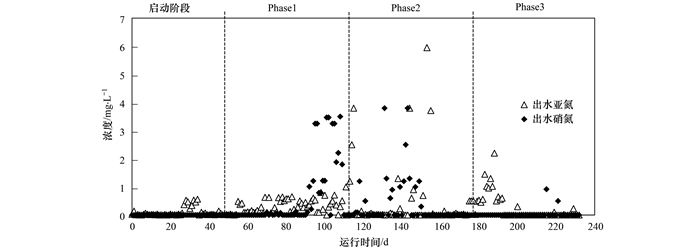
|
图 5 微气泡生物膜反应器出水亚硝酸盐和硝酸盐浓度变化 Fig. 5 Variations of nitrite and nitrate concentration in the effluent of the microbubble aerated biofilm reactor |
依据脱氮反应方程式(1)~(5)所反映的化学计量关系, 同时根据微气泡曝气生物膜反应器运行各阶段进水和出水COD、氨氮、TN、亚硝酸盐氮和硝酸盐氮浓度变化, 在已报道氮平衡模型[21]基础上考虑硝化过程, 计算厌氧氨氧化过程和反硝化过程对TN去除的贡献率, 结果如图 6所示(以Phase 3阶段为例).可以看到, Phase 3阶段厌氧氨氧化过程对TN去除的贡献率为86.0%, 反硝化过程对TN去除的贡献率为14.0%, 亦证实此时SNAD过程为TN去除的主要途径.

|
图 6 生物脱氮过程氮平衡估算模型(Phase 3) Fig. 6 Evaluation model of nitrogen balance in nitrogen removal processes (Phase 3) |
微气泡曝气生物膜反应器运行各阶段厌氧氨氧化过程和反硝化过程对TN去除的贡献率如表 2所示.可以看到, 厌氧氨氧化过程对TN去除的贡献率由启动阶段的29.4%提高至Phase3阶段的86.0%;反硝化过程对TN去除的贡献率由启动阶段的70.6%下降至Phase3阶段的14.0%.厌氧氨氧化过程在TN去除作用逐渐提高并占据优势, 是实现SNAD过程的关键环节, 同时也是Phase3阶段低C/N下获得较高TN去除性能的主要原因.
|
|
表 2 厌氧氨氧化和反硝化过程对TN去除的贡献率/% Table 2 TN contribution rates in anammox and denitrification process/% |
2.3 生物膜菌群分析 2.3.1 生物膜生物量变化
微气泡曝气生物膜反应器运行各阶段生物膜生物量变化如图 7所示.可以看到, 启动阶段生物膜生物量逐渐升高, 完成挂膜.启动阶段完成后, Phase1阶段生物膜生物量继续升高; Phase2和Phase3阶段生物膜生物量出现波动, 先有所下降, 而后升高并趋于稳定. Phase1~Phase3阶段平均SS浓度分别为1.42、2.22和2.21 g·L-1, 平均VSS浓度分别为1.06、1.77和1.92 g·L-1, 平均VSS/SS分别为0.73、0.80和0.87. Phase2和Phase3阶段降低进水COD负荷并提高TN负荷, 可能造成异养菌数量下降而自养菌数量提高, 使得生物膜生物量先下降后升高.
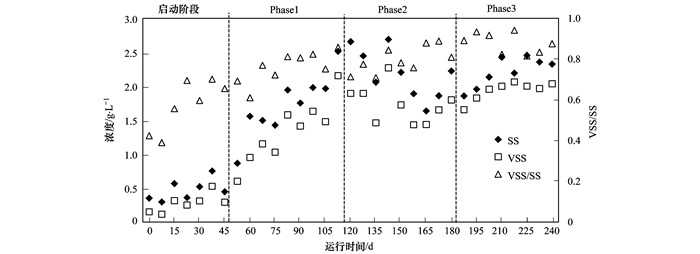
|
图 7 微气泡曝气生物膜反应器生物膜生物量变化 Fig. 7 Variations of biofilm biomass in the microbubble aerated biofilm reactor |
微气泡曝气生物膜反应器运行各阶段生物膜样品中检测得到门水平细菌种群如图 8所示.可以看到, 各阶段门水平细菌种群相对丰度有所变化, 其中的优势类群包括Proteobacteria(变形菌门)、Planctomycetes(浮霉菌门)、Bacteroidetes(拟杆菌门)、Chloroflexi(绿弯菌门)、Chlorobi(绿菌门)、Nitrospirae(硝化螺旋菌门)等.
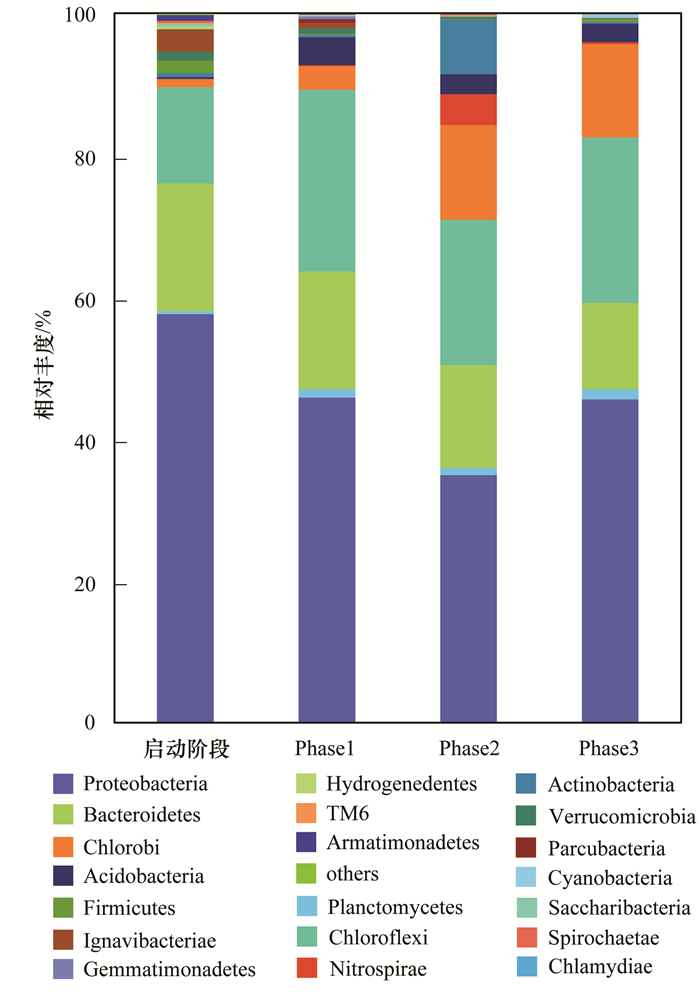
|
图 8 微气泡曝气生物膜反应器生物膜门水平细菌丰度 Fig. 8 Phylum abundances of bacterial population in the microbubble aerated biofilm reactor |
变形菌门中包括与硝化作用、亚硝化作用和反硝化作用相关的菌群; 硝化螺旋菌门亦包含硝化作用相关菌群; 浮霉菌门包含厌氧氨氧化过程相关菌群; 拟杆菌门包含与有机碳降解相关菌群; 绿弯菌门和绿菌门均属于光合细菌, 包含异养脱氮和自养脱氮作用相关菌群, 同时其往往在厌氧氨氧化过程中伴生出现, 对厌氧氨氧化菌群的形成有一定促进作用[22].
2.3.3 生物脱氮功能菌群分析微气泡曝气生物膜反应器运行各阶段生物膜样品中检测所得与生物脱氮过程相关功能菌群如表 3所示, 包括:亚硝化菌群为Nitrosomonas(亚硝化单胞菌属)和Nitrosolobus(亚硝化叶菌属); 硝化菌群为Nitrobacter(硝化杆菌属)和Nitrospira(硝化螺旋菌属); 厌氧氨氧化菌群为Candidatus Brocadia和Candidatus Kuenenia; 反硝化菌群为Denitratisoma、Pseudomonas(假单胞菌属)、Dechloromonas(脱氯单胞菌属)、Thauera(索氏菌属)以及Flavobacterium(黄杆菌属)[23~25].
|
|
表 3 微气泡曝气生物膜反应器生物膜脱氮功能菌群 Table 3 Functional bacterial populations for nitrogen removal in the microbubble aerated biofilm reactor |
计算微气泡曝气生物膜反应器运行各阶段生物脱氮过程相关功能菌群的相对丰度变化, 结果如图 9所示.可以看到, 启动阶段至Phase3阶段亚硝化菌群平均相对丰度分别为3.2%、6.0%、21.4%和21.7%;硝化菌群平均相对丰度分别为14.4%、23.8%、21.4%和12.6%;厌氧氨氧化菌群平均相对丰度分别为6.3%、11.6%、22.1%和39.9%;反硝化菌群平均相对丰度分别为49.7%、31.9%、16.1%和15.4%.
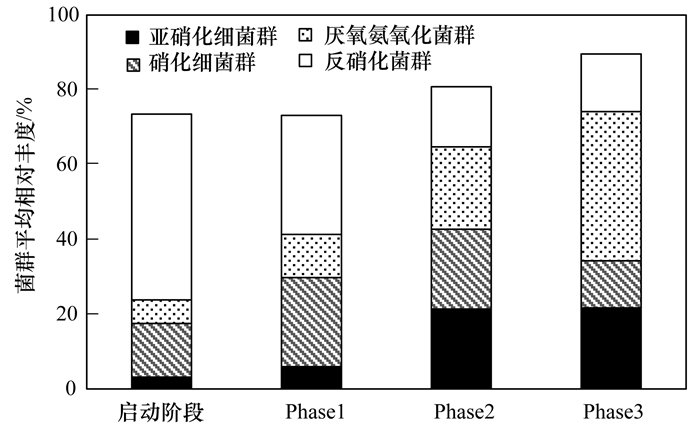
|
图 9 微气泡曝气生物膜反应器生物膜脱氮功能菌群平均相对丰度 Fig. 9 Relative abundances of functional bacterial populations for nitrogen removal in the microbubble aerated biofilm reactor |
可见, 微气泡曝气生物膜反应器运行各阶段, 亚硝化菌群和厌氧氨氧化菌群的相对丰度逐渐增加, 而硝化菌群和反硝化菌群的相对丰度逐渐降低.生物脱氮过程相关功能菌群的相对丰度变化与脱氮过程从硝化-反硝化向SNAD过程转变相一致.因此, 在微气泡曝气生物膜反应器中, 控制DO浓度并逐渐降低C/N比, 是实现SNAD过程的可行策略, 并可获得对低C/N比废水较高的生物脱氮性能.
3 结论(1) 微气泡曝气生物膜反应器在低气水比下控制DO浓度并降低进水C/N比, 可以实现脱氮过程从硝化-反硝化向SNAD过程转变, 并可获得对低C/N比废水较高的生物脱氮性能.
(2) 控制DO浓度低于1.0 mg·L-1、进水C/N比为1:2.8时, SNAD过程成为生物脱氮的主要途径, TN平均去除率可达到76.3%, TN平均去除负荷为1.42 kg·(m3·d)-1, 厌氧氨氧化过程对TN去除的贡献率为86.0%.
(3) 随着进水C/N比降低, 生物膜中亚硝化菌群和厌氧氨氧化菌群的相对丰度逐渐增加, 而硝化菌群和反硝化菌群的相对丰度逐渐降低, 与脱氮过程从硝化-反硝化向SNAD过程转变相一致.
| [1] | San-Martín M I, Mateos R, Carracedo B, et al. Pilot-scale bioelectrochemical system for simultaneous nitrogen and carbon removal in urban wastewater treatment plants[J]. Journal of Bioscience and Bioengineering, 2018. DOI:10.1016/j.jbiosc.2018.06.008 |
| [2] | 高廷耀, 顾国维, 周琪. 水污染控制工程[M]. 第四版. 北京: 高等教育出版社, 2014: 1-92. |
| [3] | Bagchi S, Biswas R, Nandy T. Autotrophic ammonia removal processes:ecology to technology[J]. Critical Reviews in Environmental Science and Technology, 2012, 42(13): 1353-1418. DOI:10.1080/10643389.2011.556885 |
| [4] | 陈家琪. SNAD-MBBR一体式生物脱氮技术研究[J]. 中国高新科技, 2018(5): 53-56. |
| [5] | Shalini S S, Joseph K. Start-up of the SHARON and ANAMMOX process in landfill bioreactors using aerobic and anaerobic ammonium oxidising biomass[J]. Bioresource Technology, 2013, 149: 474-485. DOI:10.1016/j.biortech.2013.09.104 |
| [6] |
王欢, 裴伟征, 李旭东, 等. 低碳氮比猪场废水短程硝化反硝化-厌氧氨氧化脱氮[J]. 环境科学, 2009, 30(3): 815-821. Wang H, Pei W Z, Li X D, et al. Removing nitrogen from low-C/N-piggery-wastewater using shortcut nitrification/denitrification-ANAMMOX[J]. Environmental Science, 2009, 30(3): 815-821. DOI:10.3321/j.issn:0250-3301.2009.03.032 |
| [7] | Ding S Z, Bao P, Wang B, et al. Long-term stable simultaneous partial nitrification, anammox and denitrification (SNAD) process treating real domestic sewage using suspended activated sludge[J]. Chemical Engineering Journal, 2018, 339: 180-188. DOI:10.1016/j.cej.2018.01.128 |
| [8] | Zhao J, Zuo J N, Lin J, et al. The performance of a combined nitritation-anammox reactor treating anaerobic digestion supernatant under various C/N ratios[J]. Journal of Environmental Sciences, 2015, 30: 207-214. DOI:10.1016/j.jes.2014.08.022 |
| [9] |
郑照明, 李军, 侯爱月, 等. 城市生活污水SNAD生物膜脱氮特性[J]. 中国环境科学, 2017, 37(4): 1322-1330. Zheng Z M, Li J, Hou A Y, et al. Nitrogen removal performance of SNAD biofilm cultured by domestic wastewater[J]. China Environmental Science, 2017, 37(4): 1322-1330. DOI:10.3969/j.issn.1000-6923.2017.04.016 |
| [10] | Langone M, Ferrentino R, Cadonna M, et al. Stoichiometric evaluation of partial nitritation, anammox and denitrification processes in a sequencing batch reactor and interpretation of online monitoring parameters[J]. Chemosphere, 2016, 164: 488-498. DOI:10.1016/j.chemosphere.2016.08.094 |
| [11] |
张磊, 刘平, 马锦, 等. 基于微气泡曝气的生物膜反应器处理废水研究[J]. 环境科学, 2013, 34(6): 2277-2282. Zhang L, Liu P, Ma J, et al. Wastewater treatment using a microbubble aerated biofilm reactor[J]. Environmental Science, 2013, 34(6): 2277-2282. |
| [12] |
张明, 刘春, 张磊, 等. SPG膜微气泡曝气生物膜反应器运行性能——空气通量的影响[J]. 环境工程学报, 2014, 8(10): 4067-4073. Zhang M, Liu C, Zhang L, et al. Performance of a microbubble-aerated biofilm reactor using SPG membrane system:effect of air flux[J]. Chinese Journal of Environmental Engineering, 2014, 8(10): 4067-4073. |
| [13] | Liu C, Tanaka H, Zhang J, et al. Successful application of Shirasu porous glass (SPG) membrane system for microbubble aeration in a biofilm reactor treating synthetic wastewater[J]. Separation and Purification Technology, 2013, 103: 53-59. DOI:10.1016/j.seppur.2012.10.023 |
| [14] | Zhang L, Liu J L, Liu C, et al. Performance of a fixed-bed biofilm reactor with microbubble aeration in aerobic wastewater treatment[J]. Water Science & Technology, 2016, 74(1): 138-146. |
| [15] |
刘春, 年永嘉, 张静, 等. 微气泡曝气生物膜反应器同步硝化反硝化研究[J]. 环境科学, 2014, 35(6): 2230-2235. Liu C, Nian Y J, Zhang J, et al. Simultaneous nitrification and denitrification in a microbubble-aerated biofilm reactor[J]. Environmental Science, 2014, 35(6): 2230-2235. |
| [16] | Huang X, Liu R, Qian Y. Behaviour of soluble microbial products in a membrane bioreactor[J]. Process Biochemistry, 2000, 36(5): 401-406. DOI:10.1016/S0032-9592(00)00206-5 |
| [17] |
周正, 王凡, 林兴, 等. 中试一体式部分亚硝化-厌氧氨氧化反应器的启动与区域特性[J]. 环境科学, 2018, 39(3): 1301-1308. Zhou Z, Wang F, Lin X, et al. Start-up and regional characteristics of a pilot-scale integrated PN-ANAMMOX reactor[J]. Environmental Science, 2018, 39(3): 1301-1308. |
| [18] |
赵庆良, 刘淑彦, 王琨. 复合式生物膜反应器中生物膜量、厚度及活性[J]. 哈尔滨建筑大学学报, 1999, 32(6): 39-43. Zhao Q L, Liu S Y, Wang K. Biomass, thickness and activity of biofilm in hybrid biofilm reactors[J]. Journal of Harbin University of Civil Engineering and Architecture, 1999, 32(6): 39-43. |
| [19] |
崔玉雪, 袁琦, 唐媛, 等. 水源水生物预处理中填料生物量的测定方法探讨[J]. 给水排水, 2009, 35(11): 29-31. Cui Y X, Yuan Q, Tang Y, et al. A study on measurement of biomass in the biological pretreatment process of source water[J]. Water & Wastewater Engineering, 2009, 35(11): 29-31. DOI:10.3969/j.issn.1002-8471.2009.11.008 |
| [20] | Chu Z R, Wang K, Li X K, et al. Microbial characterization of aggregates within a one-stage nitritation-anammox system using high-throughput amplicon sequencing[J]. Chemical Engineering Journal, 2015, 262: 41-48. DOI:10.1016/j.cej.2014.09.067 |
| [21] | Lan C J, Kumar M, Wang C C, et al. Development of simultaneous partial nitrification, anammox and denitrification (SNAD) process in a sequential batch reactor[J]. Bioresource Technology, 2011, 102(9): 5514-5519. DOI:10.1016/j.biortech.2010.11.024 |
| [22] |
李滨, 赵志瑞, 马斌, 等. 克隆文库方法分析厌氧氨氧化反应器中细菌群落结构[J]. 环境科学与技术, 2012, 35(12): 159-164, 179. Li B, Zhao Z R, Ma B, et al. Analysis on bacterial diversity of an anaerobic Ammonium-oxidizing reactor by use of 16S rDNA clone library[J]. Environmental Science and Technology, 2012, 35(12): 159-164, 179. DOI:10.3969/j.issn.1003-6504.2012.12.034 |
| [23] |
郑林雪, 李军, 胡家玮, 等. 同步硝化反硝化系统中反硝化细菌多样性研究[J]. 中国环境科学, 2015, 35(1): 116-121. Zheng L X, Li J, Hu J W, et al. Analysis of denitrifying bacteria community composition in simultaneous nitrification and denitrification systems[J]. China Environmental Science, 2015, 35(1): 116-121. |
| [24] | Du R, Peng Y Z, Cao S B, et al. Mechanisms and microbial structure of partial denitrification with high nitrite accumulation[J]. Applied Microbiology and Biotechnology, 2016, 100(4): 2011-2021. DOI:10.1007/s00253-015-7052-9 |
| [25] | Ye Z F, Wang F, Bi H T, et al. Denitrification of nitrate-contaminated groundwater using a simple immobilized activated sludge bioreactor[J]. Water Science & Technology, 2012, 66(3): 517-524. |
 2019, Vol. 40
2019, Vol. 40

